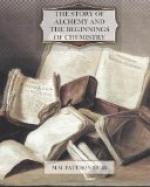Boyle published his experiments and opinions concerning the action of fire on different substances in the seventies of the 17th century; Stahl’s books, which laid the foundation of the phlogistic theory, and confirmed the alchemical opinion that the action of fire is essentially a simplifying action, were published about forty years later. But fifty years before Boyle, a French physician, named Jean Rey, had noticed that the calcination of a metal is the production of a more complex, from a less complex substance; and had assigned the increase in weight which accompanies that operation to the attachment of particles of the air to the metal. A few years before the publication of Boyle’s work, from which I have quoted, John Mayow, student of Oxford, recounted experiments which led to the conclusion that the air contains two substances, one of which supports combustion and the breathing of animals, while the other extinguishes fire. Mayow called the active component of the atmosphere fiery air; but he was unable to say definitely what becomes of this fiery air when a substance is burnt, although he thought that, in some cases, it probably attaches itself to the burning substances, by which, therefore, it may be said to be fixed. Mayow proved that the air wherein a substance is burnt, or an animal breathes, diminishes in volume during the burning, or the breathing. He tried, without much success, to restore to air that part of it which disappears when combustion, or respiration, proceeds in it.




